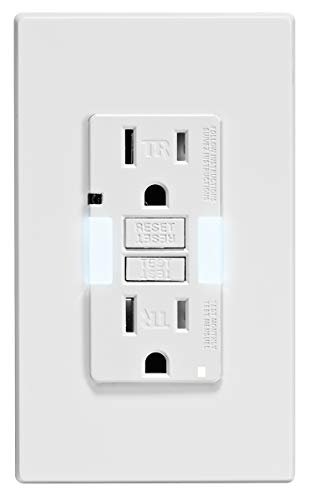Everything You Need To Know About Ground Fault Circuit Interrupter Outlets

Ground Fault Circuit Interrupter (GFCI) outlets are an essential component of electrical safety in homes and commercial buildings. These specialized outlets are designed to protect individuals from electrical shocks and prevent electrical fires caused by ground faults. In this introduction, we will explore the purpose, functionality, and benefits of GFCI outlets.
What Are Ground Fault Circuit Interrupter (GFCI) Outlets?
Ground Fault Circuit Interrupter (GFCI) outlets are electrical safety devices designed to protect against electric shock and prevent electrical fires. They are commonly used in areas where water is present, such as kitchens, bathrooms, garages, and outdoor locations.
GFCI outlets work by constantly monitoring the flow of electricity in a circuit. They detect any imbalance between the current flowing into the circuit and the current returning from the circuit. If a ground fault occurs, such as when a person comes into contact with a live wire or a faulty appliance, the GFCI outlet quickly interrupts the electrical current, preventing potential harm.
Purpose of GFCI Outlets
The primary purpose of GFCI outlets is to detect ground faults and interrupt the flow of electricity to prevent potential harm. A ground fault occurs when an electrical current deviates from its intended path and flows through an unintended conductor, such as a person or water. This can happen due to faulty wiring, damaged appliances, or exposure to moisture.
GFCI outlets are specifically designed to monitor the flow of electricity and quickly shut off power when a ground fault is detected. By doing so, they significantly reduce the risk of electric shock, protecting individuals from potentially life-threatening injuries.
How GFCI Outlets Work
GFCI outlets continuously monitor the electrical current flowing through them. They compare the current entering the outlet with the current returning from the outlet. If there is even a slight difference between the two currents, it indicates a ground fault. In such cases, the GFCI outlet immediately interrupts the electrical circuit, cutting off power within milliseconds.
To achieve this, GFCI outlets utilize a built-in sensor called a differential current transformer. This sensor continuously measures the current entering and leaving the outlet. If the difference exceeds a predetermined threshold, typically around 5 milliamperes, the GFCI outlet trips and interrupts the circuit.
Types Of GFCI Outlets
GFCI outlets come in two main types: tamper-resistant (TR) and non-tamper-resistant (NTR). Let's take a closer look at each type:
Tamper-Resistant (TR) GFCI Outlets
Tamper-resistant outlets are designed with built-in safety features to prevent accidental insertion of foreign objects into the slots. They have spring-loaded shutters that cover the slots, which only open when equal pressure is applied simultaneously to both slots. This feature provides protection against electrical shocks for children or anyone attempting to insert objects into the outlet.
TR outlets are now required by the National Electrical Code (NEC) in most residential areas for new construction or renovations.
Non-Tamper-Resistant (NTR) GFCI Outlets
Non-tamper-resistant outlets do not have the built-in shutters found in TR outlets. These outlets are more common in older homes or buildings where TR outlets were not mandated at the time of installation. While NTR outlets still provide GFCI protection, they lack the added safety measure against accidental insertion of objects.
Benefits of GFCI Outlets
GFCI outlets offer several important benefits, making them an essential safety feature in modern electrical systems:
- Protection against electric shock: GFCI outlets provide a crucial layer of protection against electrical shocks, especially in areas where water is present, such as kitchens, bathrooms, and outdoor spaces. They significantly reduce the risk of severe injuries or fatalities caused by electric shock.
- Prevention of electrical fires: By detecting ground faults and interrupting the circuit, GFCI outlets help prevent electrical fires that can result from faulty wiring or damaged appliances. This added safety measure can save lives and protect property.
- Code compliance: GFCI outlets are required by electrical codes in specific areas of residential and commercial buildings. Compliance with these codes ensures that electrical systems meet the necessary safety standards, providing peace of mind for homeowners and building occupants.
- Easy installation and retrofitting: GFCI outlets can be easily installed in place of standard outlets, making them a convenient safety upgrade. They are available in various configurations, including receptacles, circuit breakers, and portable devices, allowing for flexible installation options.
Things To Consider When Choosing A GFCI outlet
When choosing a GFCI outlet, there are a few factors to consider:
- Safety Standards: Ensure that the GFCI outlet you choose meets the necessary safety standards, such as UL (Underwriters Laboratories) certification. This ensures that the outlet has undergone rigorous testing and meets the required safety guidelines.
- Location: Consider where you plan to install the GFCI outlet. GFCIs are typically required in areas where water is present, such as kitchens, bathrooms, laundry rooms, and outdoor spaces. Make sure the outlet is suitable for the intended location and is rated for outdoor use if necessary.
- Amp Rating: Determine the appropriate amp rating for your needs. GFCI outlets are available in various amp ratings, such as 15A or 20A. Consider the electrical load of the devices you plan to connect to the outlet and choose an amp rating that can handle the required current.
- Type: There are two main types of GFCI outlets: tamper-resistant and non-tamper-resistant. Tamper-resistant outlets have features that make it difficult for children to tamper with them.
- Style: GFCI outlets come in a variety of styles, including standard, duplex, and quadplex. Standard outlets have two outlets, duplex outlets have four outlets, and quadplex outlets have six outlets.
- Features: Some GFCI outlets have additional features, such as self-test, AFCI (arc-fault circuit interrupter), and surge protection. Self-test outlets periodically test themselves to ensure that they are working properly. AFCI outlets help to protect against arc faults, which are a leading cause of house fires. Surge protection outlets help to protect against power surges, which can damage electronic devices.
- Price: GFCI outlets range in price from a few dollars to $20 or more. The price will vary depending on the type, style, and features of the outlet.
Here are some of the best GFCI outlets on the market:
- Leviton GFNL1-W Self-Test SmartlockPro Slim GFCI Tamper-Resistant Receptacle: This outlet is our top pick because it offers superior customer service, top-notch packaging, and excellent build quality at a great price. It is also tamper-resistant and has self-test and AFCI features.
- Eaton BR220M 2-Outlet Tamper Resistant GFCI Receptacle: This outlet is another great option that is both affordable and reliable. It is tamper-resistant and has self-test and AFCI features.
- Siemens Q215GFCI 125V 20A Tamper Resistant Self-Test GFCI Duplex Receptacle: This outlet is a good option for those looking for a durable and reliable outlet with a variety of features. It is tamper-resistant, has self-test, AFCI, and surge protection features.
- GE 125V 20A Tamper Resistant Self-Test AFCI GFCI Duplex Receptacle: This outlet is a good option for those looking for an affordable outlet with a variety of features. It is tamper-resistant, has self-test, AFCI, and surge protection features.
- RACO 125V 20A Tamper Resistant Self-Test GFCI Duplex Receptacle: This outlet is a good option for those looking for a durable and reliable outlet with a variety of features. It is tamper-resistant, has self-test, AFCI, and surge protection features.
Conclusion
Ground Fault Circuit Interrupter (GFCI) outlets play a vital role in electrical safety by detecting ground faults and interrupting the flow of electricity. Their ability to protect against electric shocks and prevent electrical fires makes them an essential component of modern electrical systems. By installing GFCI outlets in appropriate locations, individuals can significantly enhance the safety of their homes and workplaces.











